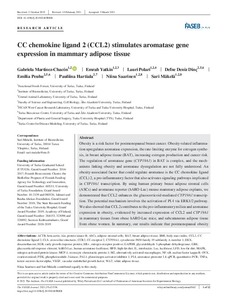CC chemokine ligand 2 (CCL2) stimulates aromatase gene expression in mammary adipose tissue
Martínez-Chacón Gabriela; Yatkin Emrah; Polari Lauri; Dinç Deniz D; Peuhu Emilia; Hartiala Pauliina; Saarinen Niina; Mäkelä Sari
CC chemokine ligand 2 (CCL2) stimulates aromatase gene expression in mammary adipose tissue
Martínez-Chacón Gabriela
Yatkin Emrah
Polari Lauri
Dinç Deniz D
Peuhu Emilia
Hartiala Pauliina
Saarinen Niina
Mäkelä Sari
Julkaisun pysyvä osoite on:
https://urn.fi/URN:NBN:fi-fe2021093047962
https://urn.fi/URN:NBN:fi-fe2021093047962
Tiivistelmä
Obesity is a risk factor for postmenopausal breast cancer. Obesity-related inflammation upregulates aromatase expression, the rate-limiting enzyme for estrogen synthesis, in breast adipose tissue (BAT), increasing estrogen production and cancer risk. The regulation of aromatase gene (CYP19A1) in BAT is complex, and the mechanisms linking obesity and aromatase dysregulation are not fully understood. An obesity-associated factor that could regulate aromatase is the CC chemokine ligand (CCL) 2, a pro-inflammatory factor that also activates signaling pathways implicated in CYP19A1 transcription. By using human primary breast adipose stromal cells (ASCs) and aromatase reporter (hARO-Luc) mouse mammary adipose explants, we demonstrated that CCL2 enhances the glucocorticoid-mediated CYP19A1 transcription. The potential mechanism involves the activation of PI.4 via ERK1/2 pathway. We also showed that CCL2 contributes to the pro-inflammatory milieu and aromatase expression in obesity, evidenced by increased expression of CCL2 and CYP19A1 in mammary tissues from obese hARO-Luc mice, and subcutaneous adipose tissue from obese women. In summary, our results indicate that postmenopausal obesity may promote CCL2 production in BAT, leading to exacerbation of the menopause-related inflammatory state and further stimulation of local aromatase and estrogens. These results provide new insights into the regulation of aromatase and may aid in finding approaches to prevent breast cancer.
Kokoelmat
- Rinnakkaistallenteet [27094]
